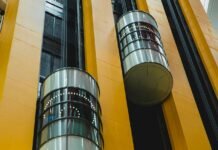Last Updated on January 21, 2024 by Asfa Rasheed
A building constructed with quality roofing materials can save thousands of dollars a year on heating and cooling. The best commercial roofing solutions can change the look of your building’s exterior, and in some cases, help the environment. There are many materials to choose from when building your roof. What are the most common commercial roofing materials in use today? What are the advantages to using these materials over others, and how long do these materials last? Read on to learn about five of the most common commercial roofing materials used in roofing today!
Table of Contents
1. Metal Roofing
Metal roofing has the longest lifespan, about forty to sixty years, and can be constructed out of many materials. You can use aluminum, tin, stainless steel, or copper. Metal roofing has high fire resistance, but can be weaker and corrode easier if not cared for properly.
The two most common metals in use for metal roofing are aluminum and steel because both are durable and are easier to paint as they hold their finishes well. Although rated for forty to sixty years, a well-constructed metal roof can last the lifespan of the building, barring catastrophic circumstances. As always, give your roof periodic checkups for leaks and other problems to ensure it has the maximum life span.
2. Built-Up Roofing
Built-up roofing is a type of membrane roofing that is made of layers of tar and gravel. It can last more than twenty years and is relatively easy to repair. Built-Up roofing has good UV resistance and is very stable, but has the shortest lifespan in commercial roofing.
This type of roofing also provides waterproofing for your building and is very low maintenance. While highly fire-resistant, they are also expensive to install and have the potential to emit hazardous fumes. Despite this, built-up roofing remains a solid choice for your building.
3. PVC and TPO Roofing
Polyvinyl Chloride (PVC) and Thermoplastic Polyolefin (TPO) are highly resistant to weather, chemicals, bacterial growth, and UV light. Both are lightweight membrane roofing that is puncture-resistant and heat reflective. PVC and TPO can vary wildly in quality depending on the manufacturer, so always go with a high-quality manufacturer.
4. Shingles
Shingles are more common on residential buildings and are made of several different materials including ceramic, slate, and plastic. Singles are affordable, however have a short lifespan and are susceptible to mildew or moss. You are choosing between convenience or lifespan with shingle-type roofs.
5. Green Roofing
Green Roofing is a more recent innovation that is both sustainable and visually appealing. These types of roofs can last anywhere from thirty to fifty years and are made with a durable and impermeable membrane that is covered by greenery. Check with your commercial roofing company for more information about these roofs that help with drainage management and climate control.
Roofing Materials
When choosing roofing materials for your commercial building it helps to keep track of your local climate, so you know what type of commercial roofing solution is right for you. Whether you go with classic metal roofing or a newer, green roofing solution, talking to your roofing contractor can better help you find the best roof for you.
Enjoy this article? Then don’t forget to check out our blog for more interesting articles!
Read More: Top Reasons Why You Need An Emergency Plumber In Charleston SC
Apart from that, if you are interested to know about The Benefits of Re-Roofing a House then visit our Home Improvement category.



























